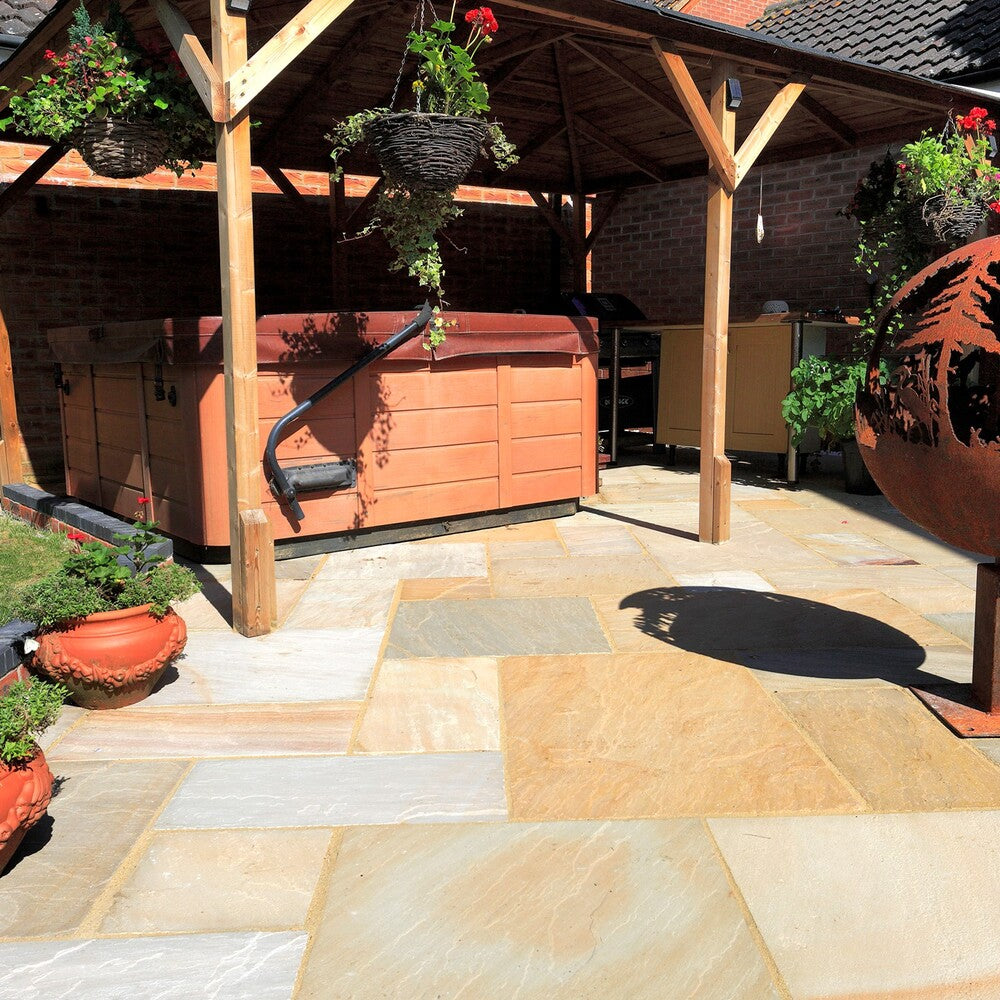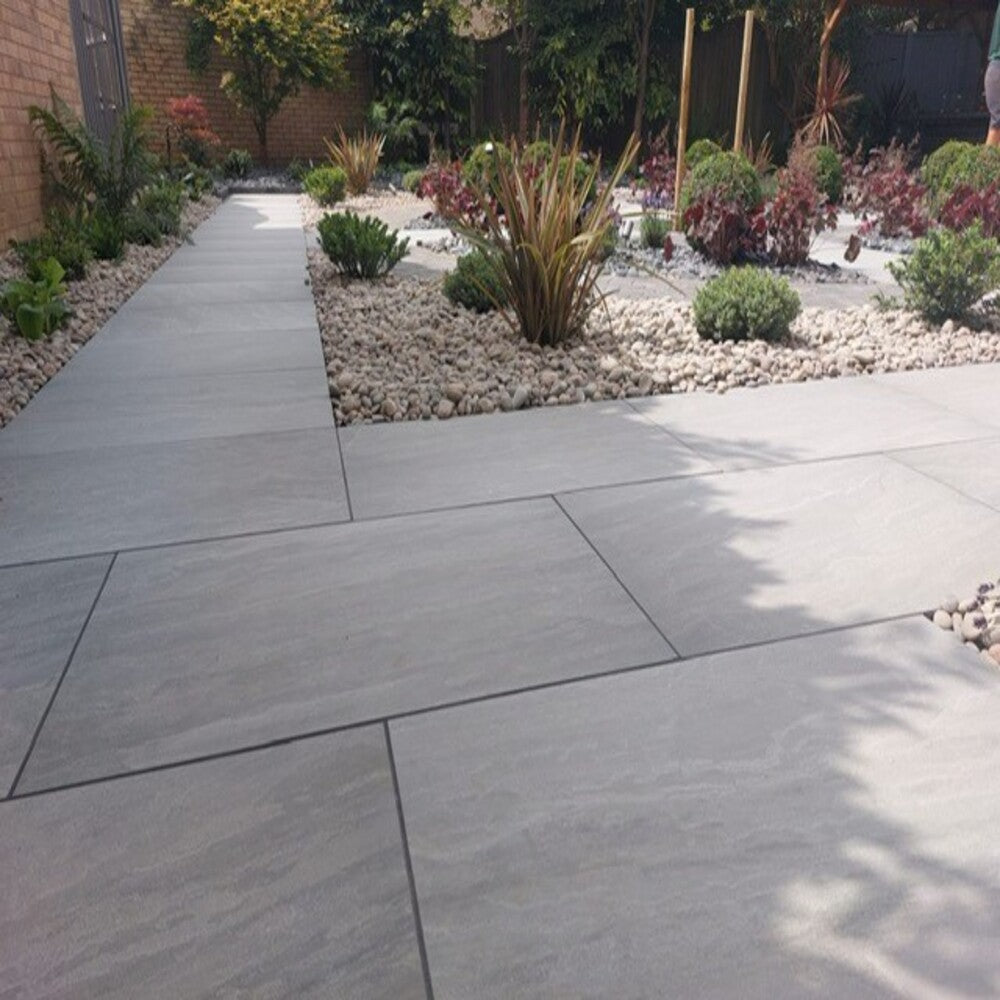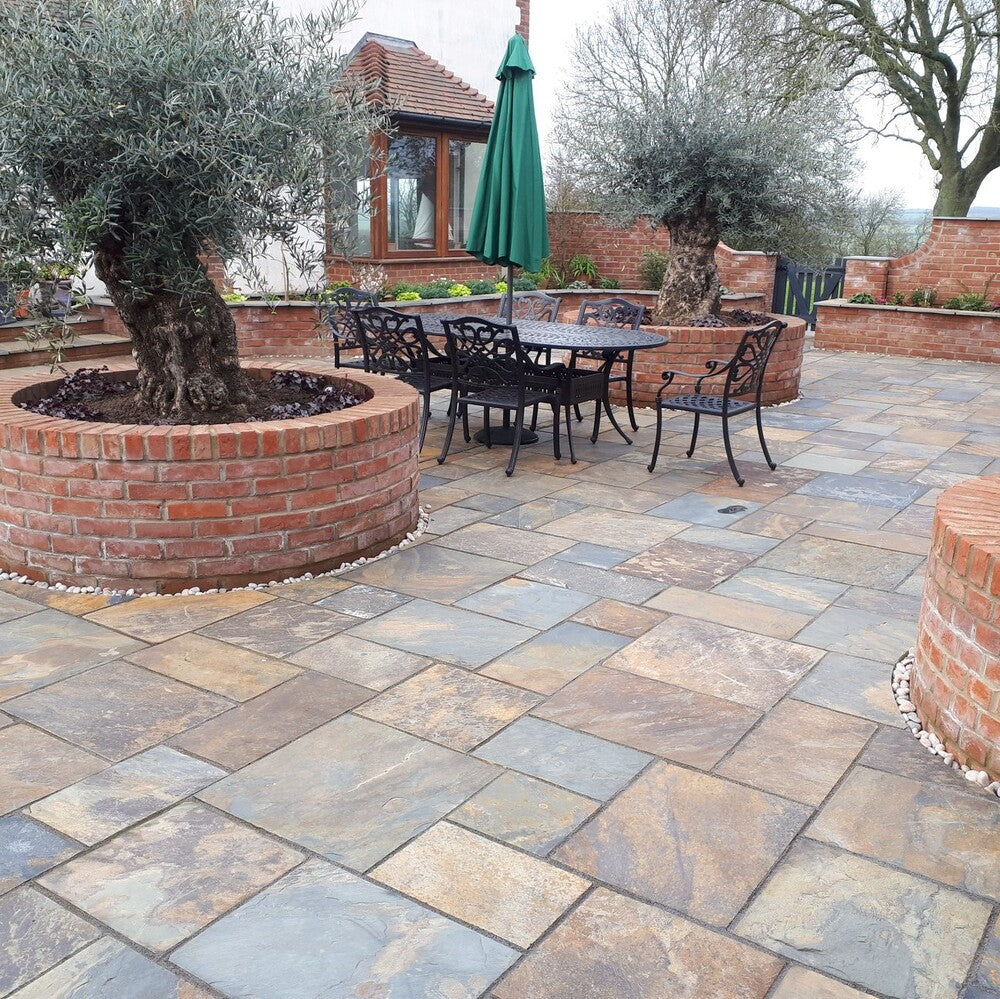If you are looking for a dense and durable paving solution for your garden, then why not consider limestone paving? Whether you consider dark, light or coloured paving, Indian limestone paving could be ideal. Our limestone patio slabs are available in black, blue or yellow to perfectly finish your garden project.
Indian limestone paving slabs have a noble and elegant natural texture. It offers high-density colours with fewer pores than other stone, and a very high level of hardness. The natural surface of Indian limestone offers a beautiful natural effect and an anti-slip property. Just one more reason that limestone paving is a popular garden paving option.

Limestone patio slabs are wear-resistant and ideal for the British climate, making them popular in gardens across the UK. Limestone paving guards against acid liquid erosion and can be cleaned easily with a neutral or mild alkaline-based cleaner which will protect and clean the limestone patio.
Many homeowners opt for limestone patio flags as it is a natural stone that looks beautiful. However, it also creates a durable, hardwearing and long-lasting surface. The great British weather can often mean rain and wet weather. However, limestone paving stones dry quickly but even when wet they offer a slip-resistant feel underfoot due to the naturally uneven surface.
Whether you are looking to create a more contemporary feel with black garden paving or a more traditional style with yellow slabs; Indian limestone paving is well worth looking at.

What Is Limestone?
Limestone is a natural material. It is made from pressurised sediment found under the sea. Limestone is a durable and natural stone. Due to the different impurities in the sediment at the time it is formed, limestone is available in a range of colours include blue, yellow and black pavers.
Limestone is a dense material. Typically, limestone is used in cement and mortar mixes. When limestone is crushed it can be used for laying road foundations. It is also commonly used in other areas that have frequent heavy-duty use.
Although limestone has been a popular building material for thousands of years, it still continues to be one of the most reliable paving options on the market today.
Is Indian Limestone Good For Patios?
Due to the high-quality stone and scuff-free finish, Indian sandstone is perfect for patios. Some natural stones will be prone to cracking and discolouring, but that’s not the case for limestone. Limestone slabs are extremely durable and a very popular choice for both long-lasting patios and garden pathways.
The textured surface and riven profile of limestone pavers is another reason that Indian limestone is ideal for patios. It offers underfoot resistance. This means you don’t need to worry about slipping when you have wet feet from a paddling pool or after heavy rainfall.
Limestone is as dense as marble. It is known as a heavy, hard-wearing stone with a light textured surface. It also doesn’t get too cold in the winter or too hot under bare feet in the warmer summer months. This is why Indian limestone isn’t just good for patios, it could be the perfect option.

What Garden Styles Is Indian Limestone Best For?
Unlike sandstone paving, limestone patio slabs yield a consistent colour palette. They offer a sophisticated finish which makes them ideal if you are trying to create a minimalistic style in your garden.
However, limestone is also a textured stone - it doesn't have significant texture markings of sandstone, but it does have a small textured effect on it, much like an orange peel. This means that a limestone patio can work really well to suit a traditional aesthetic style in your garden too. If you’re looking to complete a rustic look in your garden, we would recommend black pavers or dark grey slabs to edge and finish the rustic garden style perfectly.
It’s worth noting that it is not only outdoor areas that can benefit from charcoal paving slabs. Limestone paving can also be used inside the house as kitchen floor tiles. This offers as a seamless foundation that works extremely well in sleek, minimalistic and modern homes, as well as traditional ones.
How To Create Different Styles In Your Garden With Indian Limestone Paving
If you are looking to bring warmth to your garden and an area to enjoy the sunshine, we would recommend the yellow limestone patio slabs. These offer lights and mid beige hues which create a stunning limestone feature for your back garden.
However, if you are looking for a modern outdoor dining area, we would recommend black garden paving. This works really well when matched with glass-topped garden furniture and a minimalistic styled landscape in the garden. Black pavers offer a unique style and if you want to go lighter, you can leave them unsealed to naturally lighten in the sunlight.
Perhaps you would prefer a unique and attractive style but are put off by traditional concrete paving? Concrete can offer nice colours, but they will always fade to grey as the dye wears down. If this sounds like you, we would recommend our limestone charcoal paving slabs. These charcoal paving slabs offer a steely grey shade that offers a slip-resistant textured feel underfoot, even in wet weather. Our dark grey slabs are a more traditional paving slab that blends into your outdoor space while looking spectacular. The flat and smooth surface of the dark grey slabs offers the perfect paved flooring solution for outdoor sitting and dining areas.
Our Indian limestone blue paving slabs are a very popular choice for many homeowners. They offer unique and elegant shades of blue-grey to add a lovely and contemporary style to any outdoor space. The subtle rippled surface of the blue paving slabs provides you with a durable surface for you to enjoy your garden throughout the year.

Does Limestone Paving Need Sealant?
As with many natural stone paving options, limestone paving will require a sealant if you are keen to maintain that ‘fresh out of the box’ colour. The sealant will help maintain the bold colours of your paving stones. It will also help prevent the ingress of dirt.
If you are opting for black pavers, charcoal paving slabs or dark grey slabs, the use of a sealant is more of a necessity than a recommendation. The sealant will protect these darker garden paving options from fading to a dull grey colour over the years.
How Can I Clean My Limestone Patio?
Patios of man-made materials can be cleaned with a medley of cleaning products. However, limestone slabs are much more susceptible to chemical damage. It is important that you are careful when cleaning your limestone patio, and only use cleaning products that are safe for Indian limestone.
To maintain the sleek look of your limestone patio, you need to avoid the use of an acid-based cleaner. This will cause a chemical reaction on the surface of the stone. The reaction will permanently strip the limestone of its colour and the hardiness of the surface too.
We would recommend using either neutral or mild alkaline-based cleaner. This will clean the surface of the patio stone, as well as protect it.
For more information, read our guide on cleaning limestone.

Sandstone vs Limestone For Durability
When it comes to durability, limestone and sandstone both come out well. Weather conditions in the UK are notoriously diverse. This means that you need stone paving that will endure all the elements that the British weather offers. Both limestone and sandstone will generally tend to absorb minimal amounts of water, but they don't repel all of it. This makes both stones ideal for outdoor spaces, especially if you live in an area of the UK that is prone to rain (all of it!?).
One thing to be aware of is that the lighter shades of sandstone are more porous than the darker shades. Meanwhile, limestone, in all shades, offers the same level of porosity. If you do have lighter sandstone paving, we would recommend extra cleaning and more frequent sealant application to reduce the high porosity of the paving stone.
Both sandstone and limestone are great options. Limestone offers more consistency of colour, but sandstone is more bright and varied. Darker limestones will fade to a lighter colour, whereas sandstone will maintain its colour for a good amount of time. Overall, it's tough to recommend one over the other on durability alone - both are good options. Pick your favourite based on colour! For example, take a look at the kota blue limestone below.

Sandstone vs Limestone For Cost
Whether you’re laying a small path in the garden or laying a brand-new patio, you want patio stones that won’t cost the earth, but also that won’t let you down. Both limestone and sandstone pavers are affordable and durable. While Limestone may cost less if you were to base it on the price of paving alone (about £1-£2 per m2 less), you need to think long-term too.
Sandstone paving requires less maintenance over the years and can work out the cheaper paving option in the long run, dependent on the colour choice, cut, thickness and quality of your chosen paving stones.
Limestone offers a unique colour palette, but it requires a bit of upkeep to make sure it stays that way.
For more information, check out our guide on patio costs.

Sandstone vs Limestone For Convenience
Limestone and sandstone are often compared against each other because they are both good natural stone paving options at around the same price and quality. However, they are not identical. The biggest tell-tale sign for this is porosity.
Limestone absorbs more water than sandstone. Chemical sedimentary rocks like limestone are often called ‘evaporites’. This is because of their slip-free properties. This is why limestone natural stone flooring is more common inside homes and rooms such as kitchens and bathrooms. It’s due to the slip-free property of the stone which is important in rooms like this.
As we have already touched on, the porosity of the stone will also affect your stone paving in the long run too. Limestone paving will need more frequent cleaning and sealing than Indian sandstone. This is because sandstone absorbs and retains more water during downpours than limestone.
Sandstone vs Limestone For Maintenance
One of the biggest advantages of both limestone and sandstone is their low maintenance requirements. It’s understandable that if you have outdoor paving, you want it to last. We would always recommend that you do your research before installing your patio paving to ensure you make the most of it. For example, you should never use salt to de-ice your limestone patio.
But generally speaking, these two types of natural stone paving are relatively low maintenance. However, if you are looking for the most easily maintained option, then maybe limestone isn't for you. It is more prone to denting or scratching than sandstone as it is a harder stone so scratches on the surface are more visible. Over the years, more maintenance will be required for limestone.
Sandstone vs Limestone For Appeal
The main difference between sandstone and limestone isn’t its practical benefits, it is the aesthetic values. Limestone paving tends to be smooth and flat. The texture of limestone is often compared to that of an orange peel. However, sandstone tends to be more rippled with ridges and sometimes more chiselled edges.
If you are planning a more uniform look for a contemporary garden, then limestone is the perfect stone paving option for you. If you would prefer a more organic and rustic outdoor space, then you may opt for sandstone.
When it comes to appeal, it’s down to taste. We would recommend that you browse the options on our website where you can view our full range of limestone paving and sandstone paving options. If you’re still struggling to make the right decision for your garden project – call our team.

The Benefits Of Limestone
- Limestone is an incredibly durable material and stone that will last the test of time. You only have to look at the museums, schools, churches, mansions and other important buildings that are commonly made of limestone to see just what a hard-wearing material limestone is.
- Limestone comes in a range of yellows, blues and blacks. While it is not a huge range of colours, all the colour variations are bright, bold and look good.
- Limestone is a smooth and flat paving stone. This makes it an ideal choice for driveways, paths and patios. However, it also works well in covered outdoor areas such as courtyards.
- Limestone paving absorbs a minimal amount of water during rainfall. This makes Indian limestone paving a really good option if you live in an area of the country where there is more rain.
- Limestone is a strong stone that will easily cope with cars on a drive and high foot traffic. However, this is dependent on how thick the paving stones are and how they are laid.
Here at Primethorpe Paving, we are committed to proving you, our customer, with the best quality paving slabs for your outdoor space. We have a wide range of colours and designs to suit every garden, taste and budget. Call us now or check out our paving range online.




1 comment
Hi, would you recommend limestone paving for round a public swimming pool?